Tanja Tornede
Towards Leveraging AutoML for Sustainable Deep Learning: A Multi-Objective HPO Approach on Deep Shift Neural Networks
Apr 04, 2024Abstract:Deep Learning (DL) has advanced various fields by extracting complex patterns from large datasets. However, the computational demands of DL models pose environmental and resource challenges. Deep shift neural networks (DSNNs) offer a solution by leveraging shift operations to reduce computational complexity at inference. Following the insights from standard DNNs, we are interested in leveraging the full potential of DSNNs by means of AutoML techniques. We study the impact of hyperparameter optimization (HPO) to maximize DSNN performance while minimizing resource consumption. Since this combines multi-objective (MO) optimization with accuracy and energy consumption as potentially complementary objectives, we propose to combine state-of-the-art multi-fidelity (MF) HPO with multi-objective optimization. Experimental results demonstrate the effectiveness of our approach, resulting in models with over 80\% in accuracy and low computational cost. Overall, our method accelerates efficient model development while enabling sustainable AI applications.
Interactive Hyperparameter Optimization in Multi-Objective Problems via Preference Learning
Sep 13, 2023

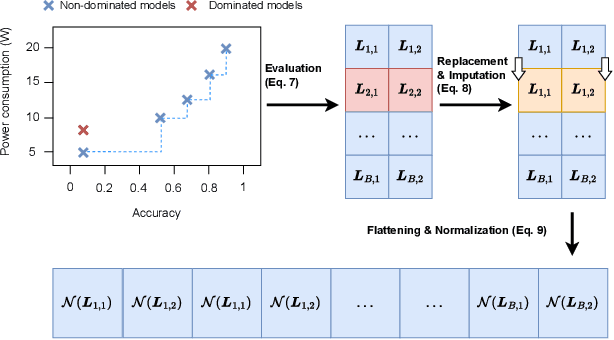
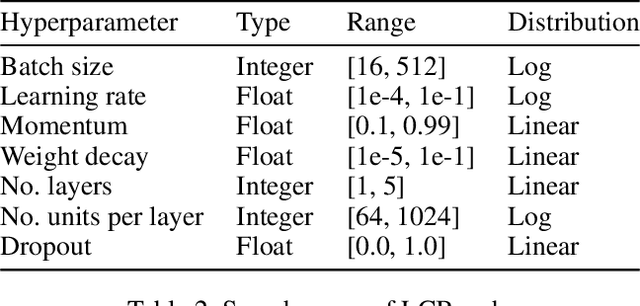
Abstract:Hyperparameter optimization (HPO) is important to leverage the full potential of machine learning (ML). In practice, users are often interested in multi-objective (MO) problems, i.e., optimizing potentially conflicting objectives, like accuracy and energy consumption. To tackle this, the vast majority of MO-ML algorithms return a Pareto front of non-dominated machine learning models to the user. Optimizing the hyperparameters of such algorithms is non-trivial as evaluating a hyperparameter configuration entails evaluating the quality of the resulting Pareto front. In literature, there are known indicators that assess the quality of a Pareto front (e.g., hypervolume, R2) by quantifying different properties (e.g., volume, proximity to a reference point). However, choosing the indicator that leads to the desired Pareto front might be a hard task for a user. In this paper, we propose a human-centered interactive HPO approach tailored towards multi-objective ML leveraging preference learning to extract desiderata from users that guide the optimization. Instead of relying on the user guessing the most suitable indicator for their needs, our approach automatically learns an appropriate indicator. Concretely, we leverage pairwise comparisons of distinct Pareto fronts to learn such an appropriate quality indicator. Then, we optimize the hyperparameters of the underlying MO-ML algorithm towards this learned indicator using a state-of-the-art HPO approach. In an experimental study targeting the environmental impact of ML, we demonstrate that our approach leads to substantially better Pareto fronts compared to optimizing based on a wrong indicator pre-selected by the user, and performs comparable in the case of an advanced user knowing which indicator to pick.
AutoML in the Age of Large Language Models: Current Challenges, Future Opportunities and Risks
Jun 13, 2023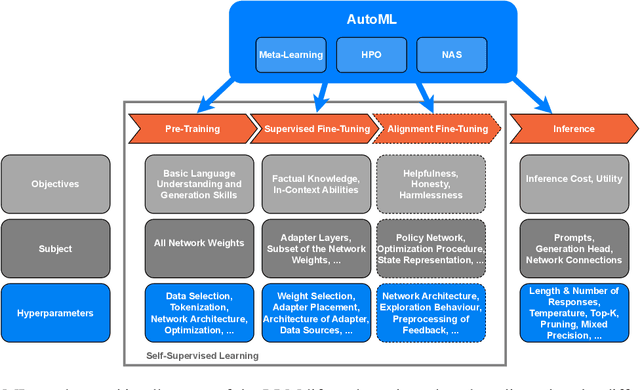

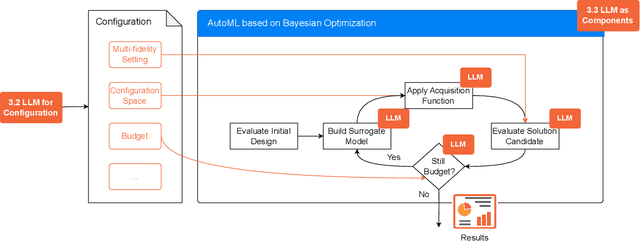
Abstract:The fields of both Natural Language Processing (NLP) and Automated Machine Learning (AutoML) have achieved remarkable results over the past years. In NLP, especially Large Language Models (LLMs) have experienced a rapid series of breakthroughs very recently. We envision that the two fields can radically push the boundaries of each other through tight integration. To showcase this vision, we explore the potential of a symbiotic relationship between AutoML and LLMs, shedding light on how they can benefit each other. In particular, we investigate both the opportunities to enhance AutoML approaches with LLMs from different perspectives and the challenges of leveraging AutoML to further improve LLMs. To this end, we survey existing work, and we critically assess risks. We strongly believe that the integration of the two fields has the potential to disrupt both fields, NLP and AutoML. By highlighting conceivable synergies, but also risks, we aim to foster further exploration at the intersection of AutoML and LLMs.
PyExperimenter: Easily distribute experiments and track results
Jan 16, 2023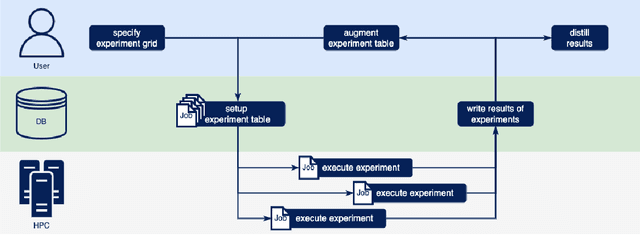
Abstract:PyExperimenter is a tool to facilitate the setup, documentation, execution, and subsequent evaluation of results from an empirical study of algorithms and in particular is designed to reduce the involved manual effort significantly. It is intended to be used by researchers in the field of artificial intelligence, but is not limited to those.
Towards Green Automated Machine Learning: Status Quo and Future Directions
Nov 10, 2021
Abstract:Automated machine learning (AutoML) strives for the automatic configuration of machine learning algorithms and their composition into an overall (software) solution - a machine learning pipeline - tailored to the learning task (dataset) at hand. Over the last decade, AutoML has become a hot research topic with hundreds of contributions. While AutoML offers many prospects, it is also known to be quite resource-intensive, which is one of its major points of criticism. The primary cause for a high resource consumption is that many approaches rely on the (costly) evaluation of many ML pipelines while searching for good candidates. This problem is amplified in the context of research on AutoML methods, due to large scale experiments conducted with many datasets and approaches, each of them being run with several repetitions to rule out random effects. In the spirit of recent work on Green AI, this paper is written in an attempt to raise the awareness of AutoML researchers for the problem and to elaborate on possible remedies. To this end, we identify four categories of actions the community may take towards more sustainable research on AutoML, namely approach design, benchmarking, research incentives, and transparency.
Algorithm Selection on a Meta Level
Jul 20, 2021
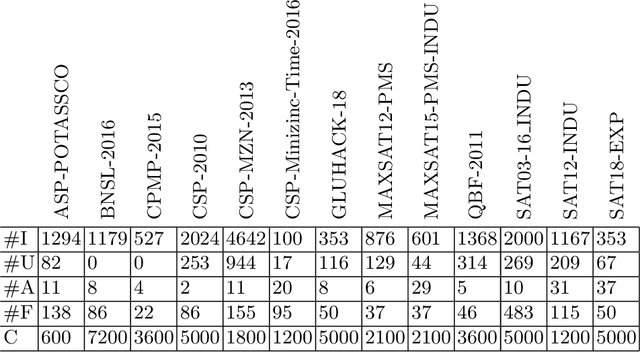
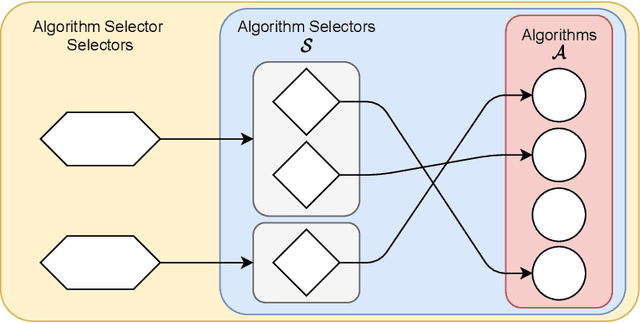
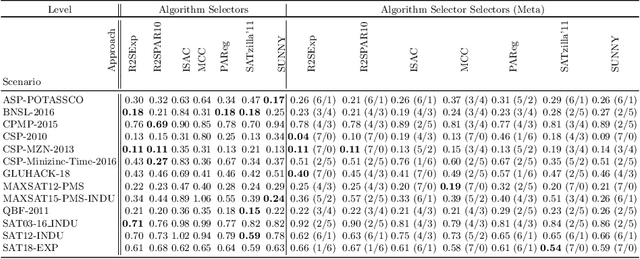
Abstract:The problem of selecting an algorithm that appears most suitable for a specific instance of an algorithmic problem class, such as the Boolean satisfiability problem, is called instance-specific algorithm selection. Over the past decade, the problem has received considerable attention, resulting in a number of different methods for algorithm selection. Although most of these methods are based on machine learning, surprisingly little work has been done on meta learning, that is, on taking advantage of the complementarity of existing algorithm selection methods in order to combine them into a single superior algorithm selector. In this paper, we introduce the problem of meta algorithm selection, which essentially asks for the best way to combine a given set of algorithm selectors. We present a general methodological framework for meta algorithm selection as well as several concrete learning methods as instantiations of this framework, essentially combining ideas of meta learning and ensemble learning. In an extensive experimental evaluation, we demonstrate that ensembles of algorithm selectors can significantly outperform single algorithm selectors and have the potential to form the new state of the art in algorithm selection.
 Add to Chrome
Add to Chrome Add to Firefox
Add to Firefox Add to Edge
Add to Edge